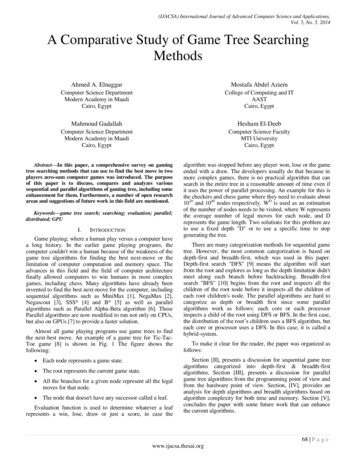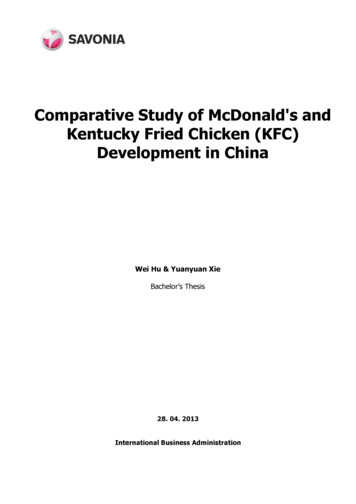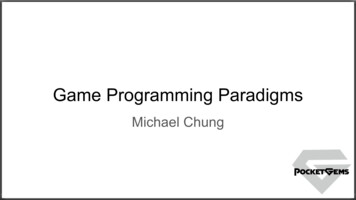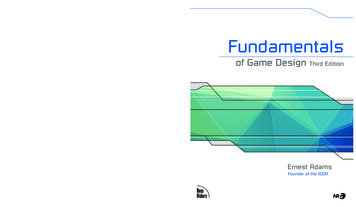
Transcription
(IJACSA) International Journal of Advanced Computer Science and Applications,Vol. 5, No. 5, 2014A Comparative Study of Game Tree SearchingMethodsAhmed A. ElnaggarMostafa Abdel AziemComputer Science DepartmentModern Academy in MaadiCairo, EgyptCollege of Computing and ITAASTCairo, EgyptMahmoud GadallahHesham El-DeebComputer Science DepartmentModern Academy in MaadiCairo, EgyptComputer Science FacultyMTI UniversityCairo, EgyptAbstract—In this paper, a comprehensive survey on gamingtree searching methods that can use to find the best move in twoplayers zero-sum computer games was introduced. The purposeof this paper is to discuss, compares and analyzes varioussequential and parallel algorithms of gaming tree, including someenhancement for them. Furthermore, a number of open researchareas and suggestions of future work in this field are mentioned.Keywords—game tree search; searching; evaluation; parallel;distributed; GPUI. INTRODUCTIONGame playing; where a human play versus a computer havea long history. In the earlier game playing programs, thecomputer couldn't win a human because of the weakness of thegame tree algorithms for finding the best next-move or thelimitation of computer computation and memory space. Theadvances in this field and the field of computer architecturefinally allowed computers to win humans in most complexgames, including chess. Many algorithms have already beeninvented to find the best next-move for the computer, includingsequential algorithms such as MiniMax [1], NegaMax [2],Negascout [3], SSS* [4] and B* [5] as well as parallelalgorithms such as Parallel Alpha-Beta algorithm [6]. TheseParallel algorithms are now modified to run not only on CPUs,but also on GPUs [7] to provide a faster solution.Almost all game playing programs use game trees to findthe next-best move. An example of a game tree for Tic-TacToe game [8] is shown in Fig. 1 The figure shows thefollowing: Each node represents a game state. The root represents the current game state. All the branches for a given node represent all the legalmoves for that node. The node that doesn't have any successor called a leaf.Evaluation function is used to determine whatever a leafrepresents a win, lose, draw or just a score, in case thealgorithm was stopped before any player won, lose or the gameended with a draw. The developers usually do that because inmore complex games, there is no practical algorithm that cansearch in the entire tree in a reasonable amount of time even ifit uses the power of parallel processing. An example for this isthe checkers and chess game where they need to evaluate about1020 and 1040 nodes respectively. WD is used as an estimationof the number of nodes needs to be visited, where W representsthe average number of legal moves for each node, and Drepresents the game length. Two solutions for this problem areto use a fixed depth "D" or to use a specific time to stopgenerating the tree.There are many categorization methods for sequential gametree. However, the most common categorization is based ondepth-first and breadth-first, which was used in this paper.Depth-first search "DFS" [9] means the algorithm will startfrom the root and explores as long as the depth limitation didn'tmeet along each branch before backtracking. Breadth-firstsearch "BFS" [10] begins from the root and inspects all thechildren of the root node before it inspects all the children ofeach root children's node. The parallel algorithms are hard tocategorize as depth or breadth first since some parallelalgorithms work as follows: each core or each processorinspects a child of the root using DFS or BFS. In the first case,the distribution of the root’s children uses a BFS algorithm, buteach core or processor uses a DFS. In this case, it is called ahybrid-system.To make it clear for the reader, the paper was organized asfollows:Section [II], presents a discussion for sequential game treealgorithms categorized into depth-first & breadth-firstalgorithms. Section [III], presents a discussion for parallelgame tree algorithms from the programming point of view andfrom the hardware point of view. Section, [IV], provides ananalysis for depth algorithms and breadth algorithms based onalgorithm complexity for both time and memory. Section [V],concludes the paper with some future work that can enhancethe current algorithms.68 P a g ewww.ijacsa.thesai.org
(IJACSA) International Journal of Advanced Computer Science and Applications,Vol. 5, No. 5, 2014II. SEQUENTIAL GAME TREE ALGORITHMSAs mentioned in the previous section, sequential algorithmswere categorized into depth-first search [9] and breadth-firstsearch [10]. Furthermore, the depth-first search algorithmscategorized again into brute-force search and selective search[11]. The brute-force search is looking at every variation to agiven depth while the selective search is looking at importantbranches only. Section [A], presents a discussion for the bruteforce search in depth-first search. Section [B], presents adiscussion for the selective search in depth-first search. Section[C], presents a discussion for the breadth-first search.Fig. 1. Game tree for Tic-Tac-Toe game using MiniMax algorithm.A. Brute-Force algorithms in Depth-First SearchThe most famous algorithms in brute-force search areMiniMax [1], NegaMax [2], Alpha-Beta [12], NegaScout [3],and Principle-Variation [13]. Following is a description of eachof these algorithms.MiniMax [1] algorithm is a game tree algorithm that isdivided into two logically stages, the first one for the firstplayer which is the computer and the second one for the secondplayer which is the human. The algorithm tries to find the bestlegal move for the computer even if the human plays the bestmove for him. Which means, it maximizes the computer scorewhen it chooses the computer move, while minimizing thatscore by choosing the best legal move for the human when itchooses the human move.In Fig. 1 there is a simulation of MiniMax search for TicTac-Toe game [8]. Every node has a value calculated by theevaluation function. For a given path, the value of the leafnodes passed back to its parent. An example for that the valueof any O's move will always choose the minimum value for thecomputer, while the value for any X's move will always choosethe maximum value for the computer.In Fig. 2 a pseudo code for the MiniMax algorithm [1] ispresented. The program first calls the function MiniMax whichstarts the chain of calls for MaxMove and MinMove. Each timeMaxMove function or MinMove function is called itautomatically calls the other function until the game ended, orit reached the desired depth.NegaMax [2] algorithm is an identical algorithm forMiniMax with only one slight difference. It uses only themaximization function rather than using both maximization andminimization functions. This can be done by negating the valuethat is returned from the children from the opponent's point ofview rather than searching for the minimum score. This ispossible because of the following mathematical relation:Max (a, b) -Min (-a, -b)(1)MinMax (GamePosition game) {return MaxMove (game);}MaxMove (GamePosition game) {if (GameEnded(game)) {return EvalGameState(game);}else {best move - {};moves - GenerateMoves(game);ForEach moves {move - MinMove(ApplyMove(game));if (Value(move) Value(best move)) {best move - move;}}return best move;}}MinMove (GamePosition game) {best move - {};moves - GenerateMoves(game);ForEach moves {move - MaxMove(ApplyMove(game));if (Value(move) Value(best move)) {best move - move;}}return best move;}Fig. 2. MiniMax Algorithm Pseduo CodeIn Fig. 3 there is a pseudo code for NegaMax algorithm.Clearly, (1) was used to simplify the MiniMax algorithm.Alpha-Beta [12] algorithm is a smart modification that canbe applied to MiniMax or NegaMax algorithms. Kunth andMoore proved that many branches could be pruned away of thegame tree which reduces the time needed to finish the tree, andit will give the same result as MiniMax or NegaMax. The mainidea of the algorithm is cutting the uninteresting branches in thegame tree. The following examples illustrating the idea:Max (8, Min (5, X)) and Min (3, Max (7, Y))The result is always 8 in the first example and 3 in the secondexample, no matter the values of X or Y. This means thealgorithm can cut the node X or Y with its branches. TheAlpha-Beta algorithm uses two variables (alpha & beta) todetect these cases, so any value less than alpha or larger than69 P a g ewww.ijacsa.thesai.org
(IJACSA) International Journal of Advanced Computer Science and Applications,Vol. 5, No. 5, 2014beta will automatically cutoff without affecting the result of thesearch tree.The enhanced version of the NegaMax algorithm from Fig.3 with Alpha-Beta property is shown in Fig. 4.// Search game tree to given depth, and return evaluation of// root node.int NegaMax(gamePosition, depth){if (depth 0 game is over)// evaluate leaf gamePositionition from// current player’s standpointreturn Eval (gamePosition);// present return valuescore - INFINITY;// generate successor movesmoves Generate(gamePosition);// look over all movesfor i 1 to sizeof(moves) do{// execute current moveMake(moves[i]);// call other player, and switch sign of// returned valuecur -NegaMax(gamePosition, depth-1);// compare returned value and score// value, update it if necessaryif (cur score) score cur;// retract current moveUndo(moves[i]);}return score;}Fig. 3. NegaMax Algorithm Pseudo CodeSeveral enhancements for the Alpha-Beta algorithm waspublished [13]; some of them is listed as follows: Move Ordering: The speed and the number of cutoffs ofthe Alpha-Beta algorithm can change dramaticallydepending on the moving search order. The best moveshould be examined first, and then the second best moveand so on. This will maximize the effectiveness of thealgorithm. Many techniques developed to solve thisproblem, including:oIterative deepening.oTransposition tables.oKiller Move Heuristic.oHistory Heuristic.improve the Alpha-Beta algorithm which discussedbelow.// Search game tree to given depth, and return evaluation of// root node.int AlphaBeta(gamePosition, depth, alpha, beta){if (depth 0 game is over)// evaluate leaf gamePositionition from// current player’s standpointreturn Eval (gamePosition);// present return valuescore - INFINITY;// generate successor movesmoves Generate(gamePosition);// look over all movesfor i 1 to sizeof(moves) do{// execute current moveMake(moves[i]);// call other player, and switch sign of// returned valuecur -AlphaBeta(gamePosition, depth-1,-beta, -alpha);// compare returned value and score// value, update it if necessaryif (cur score) score cur;// adjust the search windowif (score alpha) alpha score;// retract current moveUndo(moves[i]);// cut offif (alpha beta) return alpha;}return score;}Fig. 4. Enhanced NegaMax with Alpha-Beta Property Pseudo CodeThe NegScout [3] and Principal Variation Search [13]algorithms were based on the scout algorithm which was anenhanced version of the Alpha-Beta algorithm that can makemore cutoffs in the game tree. It contains a new test conditionthat checks whatever the first node in the siblings is either lessthan or equal to beta value or greater than or equal to the alphavalue. If the result of the condition is true, then the algorithmcuts off the root node for these siblings, and if it is false, then itsearches the rest of the siblings to get the new values of alphaand beta.In Fig. 5 there is a pseudo code for the NegaScout [3]. Itlooks like the same algorithm in Fig. 4 with the modification ofthe minimal window search. Minimal Window Search: Alpha-Beta algorithmsdepend on the values of alpha and beta to cutoff thebranches, so by narrowing the search window bychanging the values of alpha and beta; it will increasethe possibilities of the cutoffs. Many algorithms such asNegaScout [3] and MTD (f) [14] used this property toB. Selectivity algorithms in Depth-First SearchThe main difference between the brute-force algorithms andthe selectivity algorithms; it doesn't depend on fixed depth tostop looking in each branch. The most common techniques inthis category are Quiescence Search and Forward Pruning.70 P a g ewww.ijacsa.thesai.org
(IJACSA) International Journal of Advanced Computer Science and Applications,Vol. 5, No. 5, 2014Below is a discussion of the implementation of the QuiescenceSearch technique [15] and ProbCut [16] algorithm that is basedon the Forward Pruning technique.// Search game tree to given depth, and return evaluation of// root node.int NegaScout(gamePosition, depth, alpha, beta){if (depth 0 game is over)// evaluate leaf gamePositionition from// current player’s standpointreturn Eval (gamePosition);// present return valuescore - INFINITY;n beta;// generate successor movesmoves Generate(gamePosition);// look over all movesfor i 1 to sizeof(moves) do{// execute current moveMake(moves[i]);// call other player, and switch sign of// returned valuecur -NegaScout(gamePosition, depth-1,-n, -alpha);if (cur score) {if (n beta ) OR (d 2)// compare returned value and// score value, update it if// necessaryscore cur;elsescore -NegaScout(gamePosition,depth-1,-beta, -cur);}// adjust the search windowif (score alpha) alpha score;// retract current moveUndo(moves[i]);// cut offif (alpha beta) return alpha;n alpha 1;}return score;}Fig. 5. NegaScout Algorithm Pseudo Code Using the Minimal WindowSearch PrincipleQuiescence Search [15] based on the idea of variable depthsearching. The algorithm follows the normal fixed depth inmost branches. However, in some branches the algorithm takesa deeper look and increases the search depth. An example ofthat is the chess game where in critical moves like checks orpromotions, the algorithms extend the depth to make sure thereis no threat exists.In Fig. 6 there is an abstract pseudo code for theQuiescence Search that extends the depth and checks if there isany capture for pieces after a specific move or not.int Quiesce( int alpha, int beta ) {int stand pat Evaluate();if( stand pat beta )return beta;if( alpha stand pat )alpha stand pat;until( every capture has been examined ) {MakeCapture();score -Quiesce( -beta, -alpha );TakeBackMove();if( score beta )return beta;if( score alpha )alpha score;}return alpha;}Fig. 6. Abstract Pseudo Code Version for Quiescence SearchForward Pruning technique completes the idea of thevariable depth, where it cuts-off unpromising branches.However, this can lead to errors in the result. Many algorithmsimplemented the idea of this technique, including N-BestSelective Search, ProbCut and Multi-ProCut [16].N-Best Selective Search only looks for the best N-bestmoves at each node. All other siblings for the N-best moveswill automatically cutoff.Both ProbCut Multi-ProCut algorithms use the result ofshallow search to determine the possibility that a deeper searchwill change the value of alpha and beta or not.ProbCut [16] algorithm uses the statistics’ correlationtechniques to cutoff branches, because it was discovered thatthere is a strong correlation between values obtained fromdifferent depth. The relation was described by Micheal Buro asfollows:V D a * V D’ b e(2)Where V D means the value of a given depth, a & b arereal numbers and e is a normally distributed error with zeromean.Since the value of a 1, b 0 and σ2 is small in most stableevaluation function, the probability of V D beta could bepredicted from the following equivalent equation:V D’ ((1/ Φ(P))*σ beta –b) / a(3)Furthermore, the probability of V D alpha couldpredicted from the following equivalent equation:V D’ (-(1/Φ(P)*σ alpha –b) / a(4)71 P a g ewww.ijacsa.thesai.org
(IJACSA) International Journal of Advanced Computer Science and Applications,Vol. 5, No. 5, 2014In Fig. 7 there is an abstract implementation for theProbCut algorithm. Remember it's up to you to choose thevalues of D, D', the cutoff threshold (1/Φ(P)), a, b and σ. Thealgorithm can provide a faster result than any brute-forcealgorithm. However, it needs many accurate parameters, whichmay be difficult to choose and may lead to errors in the results.int alphaBetaProbCut(int α, int β, int depth) {const float T(1.5);const int DP(4);const int D(8);if ( depth 0 ) return evaluate();if ( depth D ) {int bound;// v β with prob. of at least p?// yes cutoff */bound round( ( T * σ β - b) / a );if ( alphaBetaProbCut( bound-1, bound,DP) bound )return β;// v α with prob. of at least p?// yes cutoff */bound round( (-T * σ α - b) / a );if ( alphaBetaProbCut( bound, bound 1,DP) bound )return α;}// the remainder of alpha-beta goes here.}Fig. 7. Abstract Pseudo Code Version for ProbCut Search without the alphabeta implementationMulti-ProbCut [16] algorithms generalize the idea ofProbCut by using additional cutoff thresholds and checks,including allowing more regression parameters and cutoffthresholds, using many depth pair and using internal iterativedeepening for shallow searches.C. Breadth-First SearchAs mentioned before the BFS begins from the root nodethen it visits its first child after that it visits all its siblings fromthe same depth before it moves to the next depth. One of theproblems with this technique; it requires huge memory to storenode’s data. Many algorithms use this technique like NegaC*[17], MTD (f) [14], SSS* [4], B* [5] and Monte-Carlo search[18] algorithms, which discussed below.NegaC* [17] algorithm uses the minimal-window with failsoft Alpha-Beta algorithm like NegaScout [3] algorithm, but itparses the tree in Breadth-First way. The fail-soft techniqueuses two more variables than the Alpha-Beta algorithms tocutoff more branches.In Fig. 8 there is an abstract pseudo code implementation ofthe NegaC* algorithm.int negaCStar (int min, int max, int depth) {int score min;while (min ! max) {alpha (min max) / 2;score failSoftAlphaBeta (alpha,alpha 1, depth);if ( score alpha)min score;elsemax score;}return score;}Fig. 8. An Abstract Pseudo Code Implementation of the NegaC* AlgorithmMTD (f) [14] algorithm, which is an abbreviation for"Memory-enhanced Test Driver" also uses the minimalwindow technique like NegaScout [3] algorithm, but it does itefficiently. It was introduced as an enhancement to the AlphaBeta Algorithm as mentioned before. It also uses two morevariables to determine the upper-bound and lower-bound. Thenormal Alpha-Beta algorithm uses only alpha and betavariables with - & as a start and the values are updated onetime at each call to make the only one returning value liesbetween the alpha and beta values. However, MTD (f) maysearch more than one time at each Alpha-Beta [12] call and usethe returned bounds to converge toward it using the lowerbound and upper-bound to make faster cutoffs of the tree.Furthermore, the algorithm uses a transposition table to storeand retrieve data about portions of the search tree to use it laterto reduce the over-head of re-examining same game state.However, it uses memory space to store this data, whichrequired more memory space.Fig. 9 shows a pseudo code for the MTD (f) algorithmwithout the implementation of the Alpha-Beta algorithm whichwas described in Fig. 4.SSS* [4] is another famous breadth-first search algorithm,which is non-directorial search algorithm. The algorithmexpands into multiple paths at the same time to get globalinformation of the search tree. However, it searches fewernodes than fixed depth-first algorithms like Alpha-Betaalgorithm.The algorithm stores’ information for all active nodeswhich didn't solve yet in a list in decreasing order depends ontheir importance. The information consists of three parts: N: a unique identifier for each node. S: a status of each node whatever it's live or has beensolved. H: an important value for the node.72 P a g ewww.ijacsa.thesai.org
(IJACSA) International Journal of Advanced Computer Science and Applications,Vol. 5, No. 5, 2014function MTDF(root, f, d){g : fupperBound : lowerBound : - while lowerBound upperBound{if g lowerBound thenβ : g 1elseβ : gg : AlphaBetaWithMemory (root, β-1,β, d)if g β thenupperBound : gelselowerBound : g}return g}Fig. 9. Pseudo Code for the MTD (f) Algorithm Without the Implementationof the Alpha-Beta algorithm Which was Described Previously in Fig. 4The core of the SSS* [4] algorithm depends on two phases: Node Expansion: Top-down expansion of a Minstrategy. Solution: Bottom-up search for the best Max strategy.Fig. 10 shows the pseudo code for the SSS* algorithmusing three function push, pop and insert to store, remove andupdate node information.Monte-Carlo Tree Search "MCTS" [18] algorithm made abreakthrough in game theory and computer science field. Thealgorithm is based on randomized exploration of the game tree.The algorithm also uses the results of previous examinedvalues for nodes. Every time the algorithm runs it produces abetter estimation of values. However, the game tree graduallygrows in the memory, which is the main disadvantages ofbreadth-first algorithms.The algorithm consists of four phases, which is repeated aslong as there is still time for the computer to think: Selection phase, it starts from the root node; it traversesthe game tree by selecting the most promising moveuntil reaching a leaf node. Expansion phase, if the number of visits reaches a predetermined threshold, the leaf is expanded to build alarger tree. Simulation phase, calculates the outcome value of theleaf by performing a play-out at it. Back-propagation phase, it traces back along the gametree path from the leaf to the root to update the valueschanged in the simulation phase.int SSS* (node n; int bound){push (n, LIVE, bound);while ( true ) {pop (node);switch ( node.status ) {case LIVE:if (node LEAF)insert (node, SOLVED, min(eval(node),h));if (node MIN NODE)push (node.1, LIVE, h);if (node MAX NODE)for (j w; j; j--)push (node.j, LIVE, h);break;case SOLVED:if (node ROOT NODE)return (h);if (node MIN NODE) {purge (parent(node));push (parent(node), SOLVED, h);}if (node MAX NODE) {if (node has an unexamined brother)push (brother(node), LIVE, h);elsepush (parent(node), SOLVED, h);}break;}}}Fig. 10. Pseudo Code for the SSS* AlgorithmFig. 11 shows the pseudo-code for MCTS algorithm usingthe four phases described before.B* [5] is the final algorithm that will be described in theBFS. It finds the least-cost path from the node to any goal nodeout of one of more possible goals. The main idea of thisalgorithm is based on: Stop when one path is better than all the others. Focus the exploration on paths that will lead tostopping.The algorithm expands the searching based on prove-bestand disprove-rest strategies. In prove-best strategy, thealgorithm chooses the node with the highest upper-boundbecause it has a high probability to raise its lower bound higherthan any other nodes' upper-bound when it expands. On theother hand, the disprove-rest strategy chooses the next highestupper-bound node because it has a good probability to reducethe upper-bound to less than the lower-bound of the best childwhen it expands.73 P a g ewww.ijacsa.thesai.org
(IJACSA) International Journal of Advanced Computer Science and Applications,Vol. 5, No. 5, 2014Many algorithms use the previous technique as well asother techniques, including ABDADA, Parallel Alpha-Beta,Parallel PVS, YBWC and Jamboree and Dynamic TreeSplitting. Next, a description of each algorithm is presented.Data: root nodeResult: best movewhile (has time) docurrent node root nodeABDADA is a loosely synchronized and distributedsearch algorithm designed by Jean-Christophe. The algorithmuses the shared hash table technique as well as adding moreinformation for each node like the number of processorssearching this node./* The tree is traversedwhile (current node ϵ T ) dolast node current nodecurrent node Select(current node)endParallel Alpha-Beta [6] is the parallel version of thepreviously discussed Alpha-Beta algorithm. The basic idea issplitting the search tree into sub-search trees and run each onein specific core or more in case of multi-core and one or moreprocessor in case of multi-processor system. The problem ofthis algorithm is the complexity of implementing it. However,it can maximize the utilization of the cores or processors. Thetwo methods of splitting the tree are showing in Fig. 12./* A node is addedlast node Expand(last node)/* A simulated game is playedR P lay simulated game(last node)/* The result is backpropagatedcurrent node last nodewhile (current node ϵ T ) doBackpropagation(current node, R)current node current node.parentendendreturn best move argmaxN ϵ Nc (root node)Fig. 12. Partitioning of the Game Tree for Alpha-Beta SearchFig. 11. Pseudo-Code for MCTS AlgorithmIn the next section, a discussion of most famous parallelgame tree search algorithms is presented.III.PARALLELISM IN GAME TREE SEARCHThe technological advances of the computer architectureand the release of multiprocessors and multi-core computers,allows algorithms that can be partitioned into independentsegments to be solved faster. Many enhancements were doneon the sequential algorithms to make it run in parallel as well asnew algorithms are designed for parallel computing. Theproblem of parallel computing is the trade-off between theoverhead of communication and synchronization and thebenefits of exploring many nodes in the same time in parallel.This made the speedup is sub-linear rather than linear. Section[A], presents a discussion of various techniques & algorithmsmade to solve these problems. Section [0], presents adiscussion for the parallelism of the game search tree from thehardware point of view.A. Game Tree Parallelism Techniques & AlgorithmsAs mentioned before many techniques were designed tosolve the overhead problem. One of them is the "Shared HashTable" technique, which stores information about nodes in thegame tree so it could be used by any processor or core in thesystem. This reduces the communication over-head betweenprocessors or cores, especially if the processors are not on thesame physical computer.PVS [13] algorithm expresses each node as a thread whichcan run in parallel. However, before running them in parallel,the problem of data dependency that exists among threads mustbe solved. A simple solution is to get the initial required valuefrom the first node among any siblings then run the remainingsiblings in parallel. The sequential and parallel tasks for PVSalgorithm using two processors is showing in Fig. 13 while apseudo code for the algorithm is showing in Fig. 14.Fig. 13. Sequential and Parallel Tasks by Two Processors using PVSYBWC and Jamboree algorithm [19] is shown in ,whichbased on a recursive algorithm that visits the first node insiblings before spawning the remaining sibling's nodes inparallel. It uses this technique because the first node mayproduce a cutoff so it does not waste the others processors’time by searching in the sibling nodes or will produce better74 P a g ewww.ijacsa.thesai.org
(IJACSA) International Journal of Advanced Computer Science and Applications,Vol. 5, No. 5, 2014bounds, then the algorithm search the remaining siblings inparallel. A pseudo code of the algorithm is showing in Fig. 15.PVSplit (Node curnode, int alpha, int beta, int result){if(cur node.is leaf)return Evaluate(cur node);jamboree(CNode n, int α, int β, int b){if (n is leaf)return static eval(n);c[] the childen of n;b -jamboree(c[0], -β, -α);if (b β) return b;if (b α) α b;succ node GetFirstSucc(cur node);score PVSplit(curnode, alpha, beta);In Parallel: for (i 1; i c[] ; i ){s -jamboree(c[i], -α - 1, -α);if(score beta)return beta;if(score alpha)alpha score;if (s b)b s;if (s βabort and return s;if (s α){//Wait for the completion of previousiterations of the parallel loops -jamboree(c[i], -β, -α);//Begin parallel loopwhile(HasMoreSuccessors(curnode)){succ node GetNextSucc(curnode);score AlphaBeta(succnode,alpha,beta);if(score beta)return beta;if(score alpha)alpha score;}//End parallel loopreturn alpha;if (s β)abort and return s;if (s α)α s;if (s b)b s;}Fig. 14. Pseudo Code for PVS Algorithm Using Alpha-Beta Function}Finally, DTS algorithm [20] is the most complex parallelgame tree search algorithm and there are a few implantation ofit. However, it gives the best performance in symmetric multiprocessors systems. A pseudo-code of the DTS algorithmpresented in Fig. 16.Table I shows the speedup for the three algorithmscompared using 1, 2, 4, 8, and 16 processors.TABLE I.AlgorithmPOPULAR GAME TREE PARALLEL ALGORITHMS SPEEDUPNumber of 10.9DTS1.02.03.76.611.1All the previous parallel algorithms need a parallelprogramming language or library that can handle threads andparallel computing. Many libraries and programming languageswere released to support CPU parallelism in general. However,the most famous library that used in parallel game treealgorithms is MPI (Message Passing Interface) [21] which is anextension of C programming language. MPI handles the burdenof synchronization, communication and distributed resourcesmanagement. The latest version of MPI is version 2 whichsupports C and object-oriented programming.}return b;}Fig. 15. Pseudo Code for Jamboree AlgorithmDTS(root){while (Stopping criterion() false){//One processor search to ply NSearchRoot(root);//Detect free processors, and begin tree splitSplit(node v);//Initialize new threads.ThreadInit();//Copy a “split block” to begin a new searchCopytoSMP(node v);SearchSMP(node v);}ThreadStop();}Fig. 16. Pseudo Code for DTS Algorithm75 P a g ewww.ijacsa.thesai.org
(IJACSA) International Journal of Advanced Computer Science and Applications,Vol. 5, No. 5, 2014Another trending library for artificial intelligencealgo
Almost all game playing programs use game trees to find the next-best move. An example of a game tree for Tic-Tac-Toe game [8] is shown in Fig. 1 The figure shows the following: follows: Each node represents a game state. The root represents the current game state. All the branches for a given node represent all the legal










